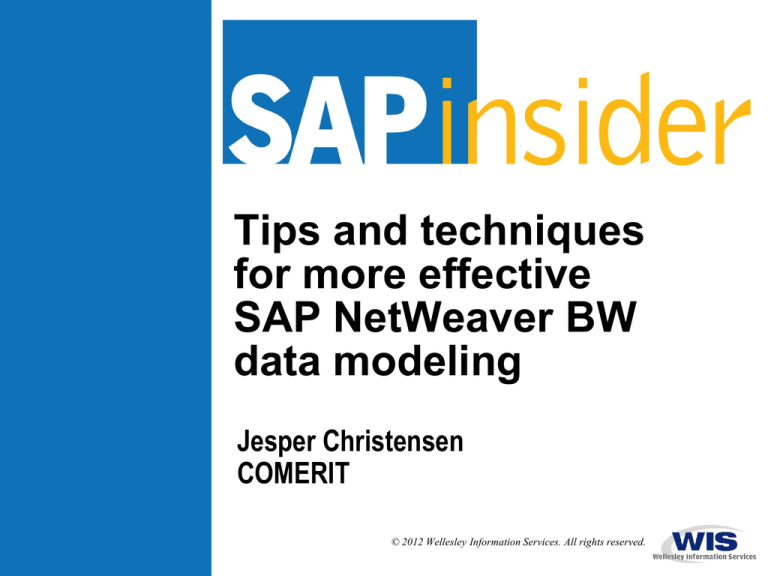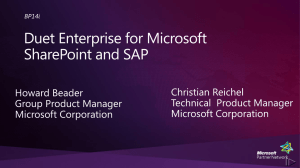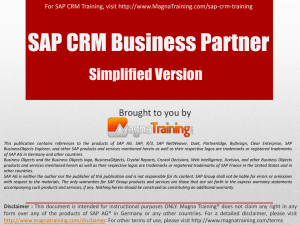
Tips and techniques
for more effective
SAP NetWeaver BW
data modeling
Jesper Christensen
COMERIT
© 2012 Wellesley Information Services. All rights reserved.
In This Session …
Tips and techniques for more effective SAP NetWeaver BW data modeling
• This session will cover the top 20 data modeling best practices for an SAP
NetWeaver BW landscape.
• Explore the benefits of techniques such as semantic partitioning and
dimensional modeling, and receive proven strategies for performing them.
• Receive best practices for optimizing data models specifically for SAP
NetWeaver BW Accelerator.
• Examine options for modeling InfoCubes for enhanced system performance,
and learn how to improve memory utilization by caching.
• Get tips for leveraging system diagnostics to identify and troubleshoot SAP
NetWeaver BW performance issues.
• Learn how and when to apply new data modeling techniques delivered with
SAP Netweaver BW 7.3, such as the Semantic Partitioning Object (SPO) and
cube-less SAP NetWeaver BW accelerator indices.
• Take home a list of best practices for optimizing InfoCube dimensions.
1
What We’ll Cover …
•
•
•
•
•
Dimensional modeling
Enterprise Data Warehouse Modeling
Modeling for performance
Modeling for in Memory
Wrap-up
2
1: Dimensional Modeling – Business requirements
•
Start with 9 questions about the requirement
Describe the business processes and analysis/reporting
requirement that define this subject area.
What granularity is required
What Dimensions are required
What Facts/measures
What additional information is required (Dimensional
Attributes)
Define frequency of dimension updates
How should the measures be aggregated/summarized
How much History is required
How frequent should the data be updated
3
1: Dimensional Modeling - ERM
•
Start the dimensional modeling with an entity relationship model
(ERM) based on the 9 decision points
Source: SAP
4
1: Dimensional Modeling – ERM (Cont.)
•
Add more details to the model based data analysis and
relationships
Source: SAP
5
1: Dimensional Modeling – Star Schema
•
Turn the ERM into a dimensional model
The fact table contains the measures
The dimension tables are de-normalised
Source: SAP
6
1: Dimensional Modeling – The Info cube model
•
The SAP Netweaver BW Infocube model is an extended star
schema
The dimension table link to infoobjects that can have master
data, texts and hierarchies maintained that can be used across
the EDW
Source: SAP
7
What We’ll Cover …
•
•
•
•
•
Dimensional modeling
Enterprise Data Warehouse Modeling
Modeling for performance
Modeling for in Memory
Wrap-up
8
Enterprise Data Warehouse modeling
•
Enterprise data warehouse modeling is all about reusability and
modeling based on current and future requirements
Reuse master data, texts and hierarchies
Reuse transaction data
Simple and standard dataflow
9
Dataflow in SAP NetWeaver BW
Source: SAP
10
2: Simplify the data flow
•
•
•
Denormalise the data during the extraction processing
Combine header and item for documents
Standardize dataflows to use DSO objects
Ensures that data can be easily reloaded
Allows for improved flexibility for the future (HANA)
An info cube should only be updated from one DSO
Simple to identify datasource
Allows for simple dataload recovery procedures
Enables immediate compression of data
11
3: Counter in DSO objects and cubes
•
Always add a counter infoobject in all DSO and Info cube
infoproviders.
This allows for
Counting no of documents etc.
Definition of process metrics
Avoids exception aggregation key figures at very granular
level
12
4: Modeling Multi-Provider
•
•
Multi-Provider should always be used for reporting even when
only 1 data target is needed for reporting, especially if there is a
possibility of logically partitioning the data target.
Multi-Providers should be used with multiple data targets when:
Business requirements combine loosely related data with
different dimensions. This data is also analyzed in separate
InfoCubes.
the number of data sources have different levels of granularity
Keep the # of data targets in a multi-provider to 10 or less.
Use Variables on 0INFOPROV or another model specific
infoobject to restrict the query to hit a specific underlying data
Multi-Provider
target.
InfoCube 1
InfoCube 2
5: Info object modeling – Business content
•
•
SAP Business Content objects will be used wherever possible to
speed up development time for the data warehouse.
Attributes should not be deleted from Business Content
objects.
Time dependency should not be changed on Business Content
objects
Enhancements should be made to Business Content without
making a copy.
Changes to length or datatype should be made in a copy of the
Business Content.
ALPHA conversion routines should not be altered
When to create a new custom Info Object
When there is no existing active or inactive Info Object with the
correct master data
6: Info object - Master Data
•
•
•
•
•
Reference characteristics must be used to limit the amount of
redundant master data
Example: 0SHIP_TO is referencing 0CUSTOMER
Define master data and texts only if needed. Master data and text
tables are not needed for info objects like document number, free
text info objects like city and keys such as zip code.
Texts should always be loaded if available in the source system
Attributes should always be loaded if available in the source
system
Hierarchies should be loaded only when required for reporting
Use upper case values for characteristic info objects that have
master data, text or hierarchy tables.
Time dependent master data, texts, and hierarchies should not be
used unless specifically required by the business.
6: Info object - Master Data (Cont.)
•
•
•
Analyze the source data and set the Text properties (short,
medium and long)
Text should be:
Marked language dependent if the source systems’ data has
language associated with the text.
Extracted for English only, unless there is a business
requirement to extract text in other languages.
Navigational attributes should be limited for performance reasons.
If an attribute is marked navigational in Business Content and is
not needed, this should be turned off before activating the
InfoCube to improve load performance.
7: Info object – F4 help
•
•
To improve query selection filter performance, set the “Query
Execution Filter Val. Selectn” for each infoobject as follows:
= M (Values in Master Data Table), if master SID records <= 100
= D (Only Values in InfoProvider), if master SID records >100.
Make this the default.
Note: User can always override to Q at query execution if
accuracy is required.
8: Info object – Key Figures
•
•
•
•
•
•
•
Key Figure data type must be valid according to data in the
source system.
Use data type of “number” when there is no relation to currency.
Limit the use of floating point data type as it can cause problems
for BWA and HANA
Do not use fixed currencies or unit of measures unless a fixed
currency or Unit is determined in a routine
Use summation aggregation in order to utilize the aggregate
functionality of SAP BW.
Use summation for exception aggregation to control the
calculation of the key figure value in BEX.
If summation is not used in the aggregation or exception
aggregation, it is recommended to use the lowest grain of time
characteristic of the InfoCube as the reference characteristic.
8: Info object – Key Figures (Cont.)
•
•
All non-cumulative key figure info objects should be approved by
the Architect
Calculated Key figures: Do not save a key figure as ratios. Instead
save numerator and denominator and calculate the ratio in BEx.
Most of the time business wants ratio of sum (not sum of ratio).
9: Use Navigational Attributes for Security
•
Use specific Security InfoObjects in your SAP Netweaver BW
system
E.g., Do not use 0COMP_CODE, instead create a reference
InfoObject (e.g., SECCOMPCD) that you add as a navigational
attribute of 0COMP_CODE
It has the same values as the base object but can be chosen to
be assigned only in the InfoProviders that require security by
the object
20
10: Enhancing and changing the data model
•
Reporting and analytical systems undergo constant change
Use SAP Netweaver BW infocubes and DSO (7.3) remodeling
tool
21
11: Enhancing and changing the data model - reloads
•
Use a custom datasource when reloading additional new fields for
an existing Logistics datasource to avoid having to load all the
data columns and avoid the setup in ECC
Example: A custom datasource to reload sales order can be
defined as a view across tables VBAK and VBAP.
This approach can also be used for other master data reloads
Reload
Datasource
Datasource
DSO
Cube
22
What We’ll Cover …
•
•
•
•
•
Dimensional modeling
Enterprise Data Warehouse Modeling
Modeling for performance
Modeling for in Memory
Wrap-up
23
12: OLAP Cache
•
OLAP Cache is the first storage that is checked for a query result
during query runtime
If the result is available in cache it is read from there and
results in the best query performance
The recommended settings are
Read Mode H
Cache Mode 5
Set the default cache settings in the infoprovider properties.
Additional Cache settings can be maintained in the query and cache
monitors t-codes RSRT and RSRCACHE
12: OLAP Cache (Cont.)
•
•
•
•
•
•
Note: Only new queries will take these settings made for the Data
Target. Settings made for the data target will not affect existing
queries; they will continue to have the old settings.
To check the current OLAP Cache settings check the system table
RSRREPDIR and fields CACHEMODE and PERSISTMODE.
If these fields are empty that means that query is not being
cached.
System transparent tables to hold the OLAP Cache data:
RSR_CACHE_DBS_BL for Across systems BLOB table
RSR_CACHE_DB_BL for Application server specific BLOB table
13: SAP NetWeaver BW 7.x Statistics
•
•
Define standard measure that can
be monitored on a daily, weekly,
and monthly basis to evaluate
data load performance trends
Records processed per minute
or Time to process 1 million
records
Time spent on extraction
Time spent in transformations
Top 10 long running loads
Total time spent for Attribute
and Hierarchy change runs
Use the standard queries and
reports as a starting point
26
13: See Details About Performance in the Monitor
•
The load monitor transaction code RSMO gives more details
about the processing steps
InfoPackage details
Data Transfer Process (DTP) details
27
14: Use SE30 to Test Performance
•
Transaction code SE30 ABAP Runtime Analysis gives a detailed
view of performance
Remember to set
the accuracy to
Low
Run
transaction
code RSA3
Note: SE30 can also be used for transformations by simulating the DTP run
28
14: Use SE30 to Test Performance (cont.)
•
Detailed Runtime will show you the bottlenecks
Sort descending based on
Net Time and you will see
your bottleneck on the top
15: Optimize Info cube Dimensions
•
•
•
Use as many dimensions as possible
Separate common filter characteristics into own dimension
Use line-item dimensions for high cardinality characteristics such
as document numbers
Do not set the high cardinality flag as this changes the index to
a b-tree index which can’t be used in star transformation
queries
Define related characteristics in the same dimension
Calculate expected number of dimensional entries
Try not to exceed 10% of expected fact table entries
30
15: Optimize Info cube Dimensions (Cont.)
•
Verify the dimension design after the first dataloads using
program SAP_INFOCUBE_DESIGNS
Allows for analysis of dimension design
31
15: Checklist for info cubes
1
Are there large dimensions (>100k records)
This should be avoided
2
Is the cube partitioned
Cubes should always be partitioned by the most used time
characteristic (0CALMONTH or 0FISCPER) try to have less
than 3M records in each partition
3
Is the cube large (> 30M records)
Consider semantic partitioning into smaller cubes by e.g. year
or geography
4
Do you have line item dimensions?
These should only be used for true line items like document
numbers.
5
Do you have high cardinality dimensions
Should not be used!
6
All cubes must be designed in a way that they can be
compressed without changing the reporting results
32
16: Implement Semantic Partitioning
•
What is it?
An architectural design to enable parallel data loading and
query execution
Partitioning criteria: Year, Region, or Actual/Plan
Source: SAP
33
16: Implement Semantic Partitioning (cont.)
•
Benefits of semantic partitioning:
Reduction in SAP NetWeaver BWA footprint (when partitioned
by year)
Parallel data loading (when not partitioned by year)
Parallel query execution
Best case when partitioning criterion is set as constant
Almost as good to create variables to filter on 0INFOPROV
Archival of a single InfoCube does not impact others
Easier DB maintenance
Performance benefits are so significant …
semantic partitioning should be deployed
on virtually every data model!
34
16: Implement Semantic Partitioning (cont.)
•
Example: Semantic partitioning by year
MultiProvider
History
(Summarized)
ALL years
Write-Optimized (No SIDs)
Ex: Current
Current
Current
Current
Current
Year
Year
Year
Year
Year
Current Year – 3
Current Year - 2
Current Year - 1
Current Year
Current Year + 1
Current Year – 3
Current Year - 2
Current Year - 1
Current Year
Current Year + 1
+ 1 =
=
- 1 =
- 2 =
- 3 =
2010
2009
2008
2007
2006
DataSource
Source: SAP
35
17: SAP Netweaver BW 7.3 SPO
•
Using the Semantic partitioning object in SAP Netweaver BW 7.3
offers an easy way to maintain semantic partitioning
Source: SAP
36
What We’ll Cover …
•
•
•
•
•
Dimensional modeling
Enterprise Data Warehouse Modeling
Modeling for performance
Modeling for in Memory
Wrap-up
37
18: Optimal model for SAP Netweaver BWA
•
•
SAP NetWeaver BWA does not support exception aggregation key
figure is releases prior to BW 7.30 / BWA 7.20
Ensure that all key figures can be aggregated
Calculate exceptions during data loading if possible
Ensure that the infocubes can be compressed and archived to
minimize the footprint in SAP Netweaver BWA
It is good practice to rebuild the BWA indices on a quarterly
basis for cubes where the data is changing frequently e.g. Sales
orders
38
18: SAP NetWeaver BW Accelerator persistence
•
•
In BW 7.3 it is possible to load data
into BWA without building an
infocube
Requires definition of a hybrid
provider based on a DSO
The hybrid provider is then
defined with all the infoobjects
of the DSO and is marked to only
store the data in BWA
Note: BWA 7.20 is required.
Latest BWA revision is
recommended for increased
stability
39
19: Optimal model for SAP HANA
•
•
•
SAP HANA is available as the DBMS for SAP Netweaver BW
This allows for additional data modeling options:
Model without cubes (Even hybrid provider is not required)
An additional info cube model is available with SAP HANA
It eliminates the dimension tables and link the fact tables
directly to the SID tables of the infoobjects
Existing infocubes can be converted using t-code
RSMIGRHANADB
40
20: BW Work Spaces in SAP Netweaver 7.3
•
BW work spaces are new in BW 7.3
Allows for combining local development with the corporate
governed Data Warehouse
Local data files can be loaded
The work spaces are defined by IT but can be managed and
changed by business users
Source: SAP
41
20: BW Work Spaces in SAP Netweaver 7.3 (Cont.)
•
Workspace Designer for key users in
business departments
Browser-based tool running in
SAP NetWeaver Business Client
or SAP NetWeaver Portal
Easy upload of local flat files,
Query results and BW
DataSources into Local Provider
Merge data of Local Providers
with data from SAP NetWeaver
BW to create new data models
(CompositeProvider)
Monitor Workspace with regards
Source: SAP
to size and number of objects
created
42
What We’ll Cover …
•
•
•
•
•
Dimensional modeling
Enterprise Data Warehouse Modeling
Modeling for performance
Modeling for in Memory
Wrap-up
43
Additional Resources
•
•
•
Data Modeling in SAP NetWeaver BW - Frank K. Wolf, Stefan
Yamada
http://www.sap-press.com/products/Data-Modeling-in-SAPNetWeaver-BW.html
Using Semantic Partitioning
http://help.sap.com/saphelp_nw73/helpdata/en/4a/0905c133e00
890e10000000a421937/frameset.htm
Multi-Dimensional Modeling with BI
http://www.sdn.sap.com/irj/scn/index?rid=/library/uuid/6ce7b0a
4-0b01-0010-52ac-a6e813c35a84
44
7 Key Points to Take Home
•
•
•
•
•
•
•
Data modeling should be based on business requirements and
good analysis of the underlying data
Modeling an enterprise data warehouse requires standards and
best practices to be applied
All reporting should be based on a multiprovider
Info Object modeling is very important to an enterprise data
warehouse model as they should be reused across all models
Use the remodeling tool to change DSO and cube models
Review datamodels for performance prior to go live
Implement BWA or HANA to increase reporting performance and
apply additional time saving modeling options
45
Your Turn!
How to contact me:
Jesper Moselund Christensen
jesper@comerit.com
46
Disclaimer
SAP, R/3, mySAP, mySAP.com, SAP NetWeaver®, Duet®, PartnerEdge, and other SAP products and services mentioned herein as well as their
respective logos are trademarks or registered trademarks of SAP AG in Germany and in several other countries all over the world. All other product
and service names mentioned are the trademarks of their respective companies. Wellesley Information Services is neither owned nor controlled by
SAP.
47












